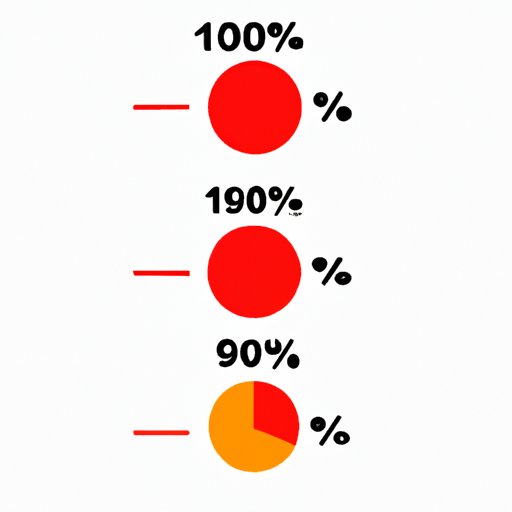
Introduction
Do you remember learning about percentages in school? If not, don’t worry; we’ve got you covered. A percentage is a way of representing a fraction or decimal as a portion of 100. Understanding how to work with percentages is essential for everyday life, from calculating sales discounts to figuring out how much you need to tip your server. This article will provide you with a comprehensive guide on how to do percentages, including real-life examples, video tutorials, infographics, case studies, calculators tools, and quizzes.
A Step-By-Step Guide
Percentage calculations may seem daunting, but they’re not as complicated as they might appear. By following a few simple steps, you’ll be able to calculate percentages quickly and accurately.
There are three methods for calculating percentages:
1. Proportions Method
2. Percentage Formula Method
3. Cross-Multiplication Method.
In the following subsections, we will break down each of these methods step-by-step and provide examples to help you understand how to do percentages better.
Proportions Method
The proportions method is a straightforward technique that involves setting up a fraction with the given percentage on the top and 100 on the bottom.
Here’s the formula:
Percentage / 100 = Part / Whole
To calculate the part (or the proportion), multiply the whole by the percentage and then divide the result by 100.
Let’s look at an example:
What is 25% of 80?
Solution:
25 / 100 = x / 80
The proportion can be simplified as follows:
1 / 4 = x / 80
To find x, multiply both sides of the equation by 80:
80 x 1 / 4 = 20
Therefore, 25% of 80 is 20.
Percentage Formula Method
The percentage formula method involves a simple formula that allows you to calculate the percentage by multiplying the given number by the percentage and then dividing the result by 100.
Here’s the formula:
Percentage = (Part / Whole) x 100
Let’s use the previous example to demonstrate this method:
What is 25% of 80?
Solution:
Percentage = (Part / Whole) x 100
Percentage = (x / 80) x 100
Percentage = 0.25 x 80
Therefore, 25% of 80 is 20.
Cross-Multiplication Method
The cross-multiplication method is another way to calculate percentages. It involves writing the percentage as a fraction and then cross-multiplying to find the missing value.
Here’s the formula:
Percentage / 100 = Part / Whole
Cross-multiplying, we get:
Percentage x Whole = 100 x Part
Let’s use the same example:
What is 25% of 80?
Solution:
Percentage x Whole = 100 x Part
25 x Whole = 100 x 80
Whole = 100 x 80 / 25
Therefore, 25% of 80 is 20.
These three methods are the most widely used to calculate percentages. Depending on the situation, you may find one method more convenient than the others.
Video Tutorial
While written explanations can be helpful, visual aids can sometimes be more effective. That’s why we’ve created a video tutorial to help you learn how to calculate percentages easily.
Our video tutorial uses animated graphics and real-life examples to walk you through each step of the percentage calculation process. We’ll show you how to use each of the three methods and provide tips for reinforcing your learning.
Infographic
Infographics are another powerful tool that can make complicated concepts easier to understand. That’s why we’ve developed an infographic that breaks down the basics of percentage calculations in a visual, easy-to-understand format.
Our infographic uses charts, diagrams, and images to explain the concepts quickly and memorably. You’ll be able to see each of the three methods in action and understand the situations where they are most useful.
Case Study
Every critical decision requires a good analysis of data, and percentages play an essential role in the analysis. In this case study, we’ll introduce you to a small business owner who used percentages to analyze data, make informed decisions and achieve their goals.
Suppose a small business owner wanted to increase their revenue by analyzing their sales data. By using percentages, they were able to gain valuable insights into their customers’ behavior and make critical decisions about their business.
Our case study will cover how percentages were used to analyze data, interpret patterns, and make informed business decisions. You’ll learn how to apply percentage calculations in real-life situations effectively.
Calculator Tool
We understand that calculating percentages can be time-consuming and complicated, especially when dealing with large numbers. That’s why we’ve created an online calculator tool to make your life easier.
Our calculator is a user-friendly tool that provides quick, accurate percentage calculations. You’ll be able to use the calculator to perform simple percentage calculations in no time. Additionally, our tool provides instructions on how to solve more complex percentage problems.
Quiz
They say practice makes perfect, and the best way to reinforce your learning is with a quiz. Our quiz is designed to test your knowledge of percentage calculations and help you identify areas where you need more practice.
The quiz contains multiple-choice, true/false, and short-answer questions. It covers all the basics of percentage calculations, including the three methods and real-life examples. We’ll provide feedback and explanations for the correct solutions, helping you to improve your percentage calculation abilities further.
Conclusion
Calculating percentages is a vital skill that is used in countless areas of everyday life. Understanding how to do percentages can help you make informed decisions, whether you’re managing your finances or running a business. By following the steps outlined in this article, taking advantage of our video tutorial, infographic, case study, calculator tool, and quiz, you can master the art of percentage calculations quickly and accurately.
Practice your newfound skills often to improve your abilities and become more comfortable with the concepts involved. Keep learning and discovering new ways to apply percentages in your daily life.




